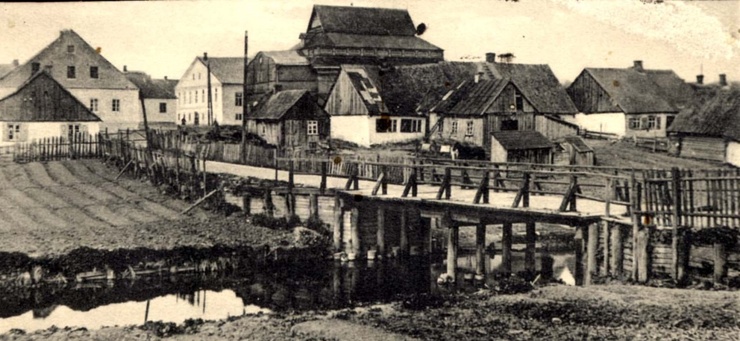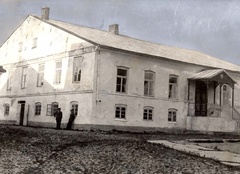Vilkaviskis
Pronounced “Vill-kah-VISH-kiss” (Polish: Wyłkowyszki; Yiddish: Vilkovishk; German: Wilkowischken; Russian: Вилковишки / Vilkovishki)
Jews first settled in Vilkaviškis around the late 1400s and early 1500s. In 1545 the community constructed a grandiose wooden synagogue. The building included a three-story Holy Ark that housed sacred scrolls Jews brought with them after being expelled from Spain in 1492. In 1812 this and other synagogues would be used as lodging for Napoleon and his troops as they passed through the town.
By 1857 the Jews of Vilkaviškis made up more than 80 percent of the town’s population (approximately 4,500 of 5,500 total). However, Jews contended with antisemitic policies imposed by the Russian Empire that took control of the area in 1815. For example, no new Jewish families were allowed to settle in Vilkaviškis because of its location 11 miles east of the border with the Prussian (German) Empire.
Most Jews worked in trade or as artisans and a large number worked in the town’s brush-making industry. In the late 1890s these workers organized a “Brushmakers Bund” that fought for the rights of laborers. The Zionist party that advocated for the creation of a Jewish state also gained a large following.
During World War I (1914-1918) Vilkaviškis was occupied by the German army. During this time a Jew, Bendet Rabinovitz, served as the mayor of the town.
After the war Lithuania was re-established as an independent country. In the 1920s and 1930s the roughly 3,400 Jews of Vilkaviškis made up about 40 percent of the town’s total population and Jews held about half of the seats on the city council. Of the 154 small shops in the town, 130 (84 percent) were owned by Jews. Survivor Morris Penn remembered, “We had shoemakers and tailors and bakers, and we had butchers…also carpenters.”
Penn attended a Hebrew high school, one of many Jewish schools in Vilkaviškis. Jews could worship in one of six synagogues and prayer houses, including the old wooden synagogue built in the 1500s. Penn remembered that, like the rest of the decidedly Orthodox community, his father was “very religious.” Penn said, “He used to pray three times a day… It was a vibrant Jewish community.”
This community was swiftly destroyed during World War II. In 1940 Vilkaviškis was occupied by Soviet forces. Less than two years later, on June 22, 1941 the city was bombed by the German military, destroying the nearly 400-year-old wooden synagogue.
On July 27, 1941, Penn was among the approximately 250 men and teenagers who were ordered to dig huge pits outside of the city. The next day nearly 900 men, including Penn’s father and brother, were lined up and shot into these mass graves. Two months later any surviving women and children met the same fate. The centuries-old Jewish community of Vilkaviškis was annihilated within two months of the Nazi invasion.
Vilkaviskis: Photographs & Artifacts
-
 General view of the town of Vilkaviškis, prewar. The tallest building in the photograph is the wooden synagogue built in 1545. Credit: Yad Vashem
General view of the town of Vilkaviškis, prewar. The tallest building in the photograph is the wooden synagogue built in 1545. Credit: Yad Vashem -
 The great wooden synagogue of Vilkaviškis, prewar. Credit: Yad Vashem
The great wooden synagogue of Vilkaviškis, prewar. Credit: Yad Vashem -
 The exterior of a synagogue in Vilkaviškis, prewar. Credit: Yad Vashem
The exterior of a synagogue in Vilkaviškis, prewar. Credit: Yad Vashem -
 The cornerstone setting ceremony for an old age home in Vilkaviškis. Credit: Yad Vashem
The cornerstone setting ceremony for an old age home in Vilkaviškis. Credit: Yad Vashem -
 Destroyed buildings in Vilkaviškis. Credit: Yad Vashem
Destroyed buildings in Vilkaviškis. Credit: Yad Vashem
Destroyed Communities Memorial Slope
Vilkaviskis: Survivors

Many times I wished I could cry a little. It would get easier, take off that heavy rock from your heart. But I couldn’t cry. There were no tears. And many times, of course, I wished I wouldn’t wake up. But then there were times I thought maybe I’m the only one in hiding, and the world won’t know what they did to the Jewish people. So I’ve got to go on.





